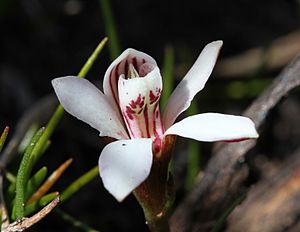Lizard orchid facts for kids
Quick facts for kids Lizard orchid |
|
|---|---|
 |
|
| Scientific classification | |
| Genus: |
Burnettia
|
| Species: |
cuneata
|
| Synonyms | |
The lizard orchid (scientific name: Burnettia cuneata) is a special kind of flowering plant. It's the only species in its group, called Burnettia, and it belongs to the big Orchid family. This orchid doesn't have regular leaves. Instead, it gets its food from fungi in the soil, which is a unique way to live! It has one or two small, leaf-like parts called bracts and can grow up to seven flowers. These flowers are brownish on the outside and pretty pink or white inside. You can only find the lizard orchid in southeastern Australia, where it likes to grow in thick, bushy areas in swamps.
What the Lizard Orchid Looks Like
The lizard orchid, Burnettia cuneata, is a plant that doesn't have typical leaves. It's a type of herb that gets its food from fungi in the ground. It has one small, leaf-like part called a bract. This bract is shaped like a spear or an egg. It is about 10 to 20 mm (0.4 to 0.8 inches) long and 6 to 8 mm (0.2 to 0.3 inches) wide near its base.
The stem that holds the flowers is thick and dark purplish-brown. It grows to be about 30 to 130 mm (1.2 to 5.1 inches) tall. This stem can have up to seven flowers on it. Each flower is about 10 to 12 mm (0.4 to 0.5 inches) long and 20 to 25 mm (0.8 to 1.0 inch) wide. The outside of the flowers is brownish, while the inside is pink or white.
The flower parts that look like petals, called sepals and petals, are shaped like spears. They are narrower at the bottom. These parts are about 10 to 130 mm (0.4 to 5.1 inches) long and 3 to 4 mm (0.1 to 0.2 inches) wide. The top sepal forms a kind of hood over the central part of the flower, called the column. The special lower petal, called the labellum, has dark red stripes. It's shaped like a wedge and is about 6 to 7 mm (0.2 to 0.3 inches) long. It also has two raised lines along its middle.
Lizard orchids usually flower between September and December. But here's a cool fact: they almost always only flower after there has been a fire in the area during the previous summer!
How it Got its Name
The lizard orchid was first officially described in 1840 by a person named John Lindley. He found a sample of the plant in Tasmania. He then wrote about it in his book, The Genera and Species of Orchidaceous Plants.
The second part of its scientific name, cuneata, comes from a Latin word. It means "wedge-shaped," which describes the shape of the flower's labellum.
Where the Lizard Orchid Lives
The lizard orchid grows in dense, bushy areas in swamps close to the coast. It likes to live among thickets of other plants like Melaleuca and Leptospermum.
You can find this orchid in several parts of southeastern Australia. It grows in New South Wales, south of the Blue Mountains. It also lives in Tasmania and Victoria. In Victoria, you can find it between Portland and Mallacoota. There's also a separate group of these orchids living in the Grampians.

